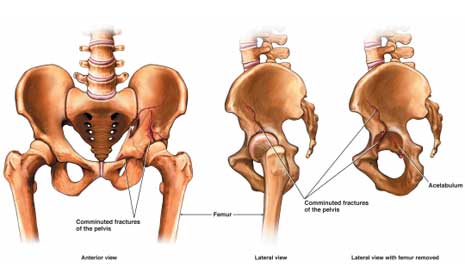
Fracture of Acetabulum & Pelvis Bone
An acetabular fracture is a break in the socket portion of the “ball-and-socket” hip joint. These hip socket fractures are not common — they occur much less frequently than fractures of the upper femur or femoral head (the “ball” portion of the joint).
The majority of acetabular fractures are caused by some type of high-energy event, such as a car collision. Many times patients will have additional injuries that require immediate treatment.
In a smaller number of cases, a low-energy incident, such as a fall from standing, may cause an acetabular fracture in an older person who has weaker bones.
Treatment for acetabular fractures often involves surgery to restore the normal anatomy of the hip and stabilize the hip joint
Treatment
Your doctor will consider several things when planning your treatment, including:
• The specific pattern of the fracture
• How much the bones are displaced
• Your overall health condition
Nonsurgical Treatment
Nonsurgical treatment may be recommended for stable fractures in which the bones are not displaced. It may also be recommended for patients who are at higher risk for surgical complications. For example, patients with severe osteoporosis, heart disease, or other medical concerns may not be able to tolerate surgery.
Nonsurgical treatment may include:
• Walking aids. To avoid bearing weight on your leg, your doctor may recommend that you use crutches or a walker for up to 3 months—or until your bones are fully healed.
• Positioning aids. If your doctor is concerned about joint instability—the ball of your hip sliding within or popping out of the socket— he or she may restrict the position of your hip, limiting how much you are allowed to bend it. A leg-positioning device, such as an abduction pillow or knee immobilizer, can help you maintain these restrictions.
• Medications. Your doctor may prescribe medication to relieve pain, as well as an anti-coagulant (blood thinner) to reduce the risk of blood clots forming in the veins of your legs.
• Surgical Treatment
Most acetabular fractures are treated with surgery. Because acetabular fractures damage the cartilage surface of the bone, an important goal of surgery is to restore a smooth, gliding hip surface.
During the operation, your doctor will reconstruct the normal anatomy of the hip joint—aligning the bone fragments to restore the surface of the acetabulum, and fitting the femoral head into the hip socket.
Timing of surgery. Most acetabular fractures are not operated on right way. Your doctor may delay your surgery a few days to make sure your overall condition is stable and you are prepared for the procedure.
During this time, your doctor may place your leg in skeletal traction to immobilize the fracture and prevent additional injury or damage to the hip socket. In skeletal traction, a metal pin is implanted in the femur or tibia bone. Weights attached to the pin gently pull on the leg, keeping the broken bone fragments in as normal a position as possible. For many patients, skeletal traction also provides some pain relief.
Open Reduction and Internal Fixation
During surgery, the displaced bone fragments are first repositioned (reduced) into their normal alignment. Your doctor will then attach metal plates and screws to the outer surfaces of the bone to hold the fragments together while they heal.
Depending upon the location of your fracture, your doctor will make an incision along the front, side, or back of your hip. Occasionally, a combination of approaches or an alternative approach is used.

(Left) This x-ray shows a fracture of the back “wall” of bone supporting the hip.(Right) Here, plates and screws have been used to repair the fracture.
Total Hip Replacement
In some cases, the acetabulum is so damaged that repair or reconstruction is unlikely to provide a good long-term result. In this situation, your doctor may recommend total hip replacement. In this procedure, the damaged bone and articular cartilage are removed and replaced with artificial parts (prosthesis).
Whenever possible, the doctor will reposition the bones into their normal alignment using screw and plate fixation before performing the total hip replacement. However, if this is not feasible, the doctor may delay the procedure for a period of time to allow the fracture to first heal in its unaligned position. He or she will then perform the total hip replacement—replacing the irregular hip socket with the total hip prosthesis.
Your doctor will consider many factors, including your age and activity level, in determining whether total hip replacement is the most appropriate treatment.

In this x-ray, the head of the femur and the damaged acetabulum have been replaced with a total hip prosthesis.
 179-FB Scheme No.94,Pipliyahana Chouraha,Indore
179-FB Scheme No.94,Pipliyahana Chouraha,Indore 09329245454,09893772745
09329245454,09893772745
